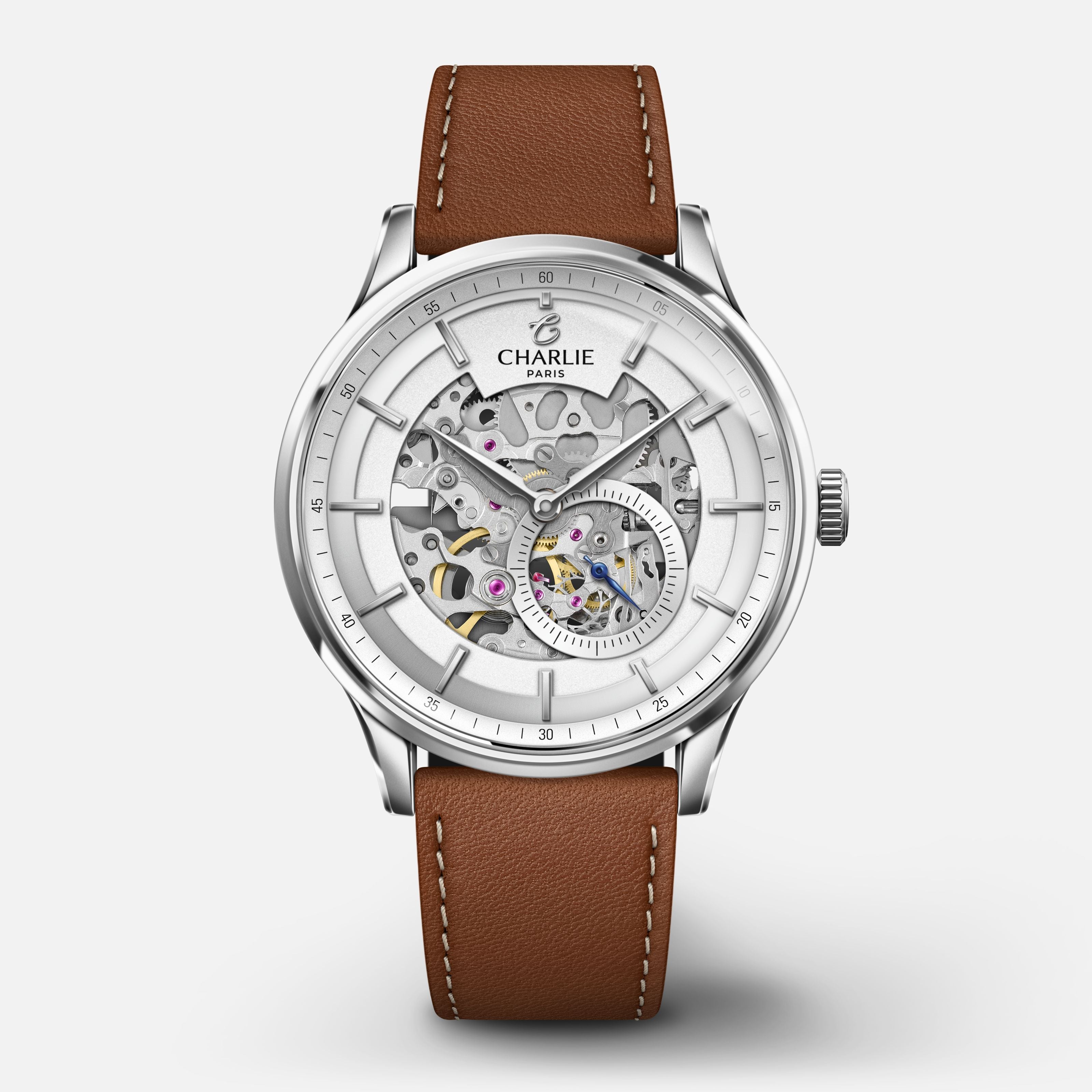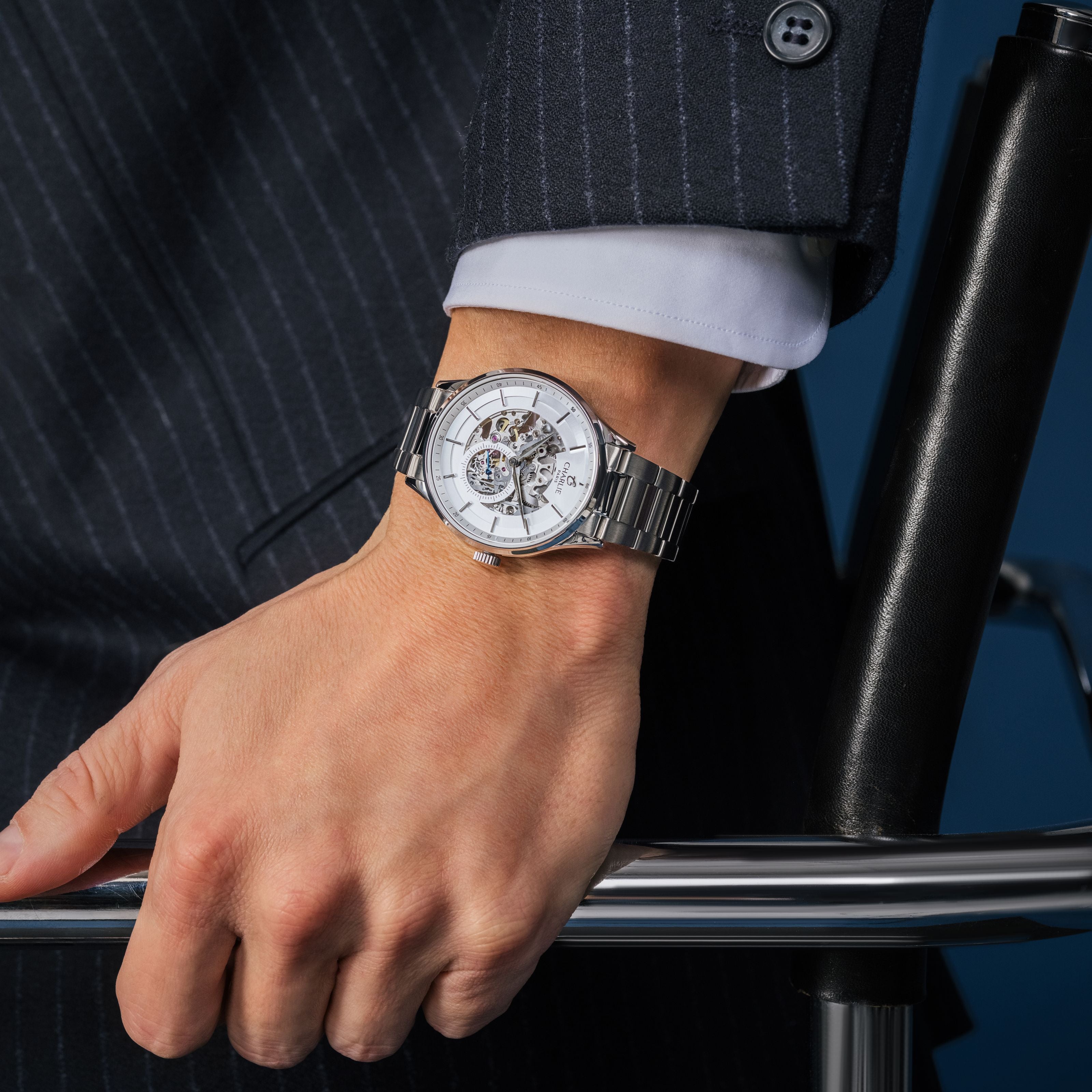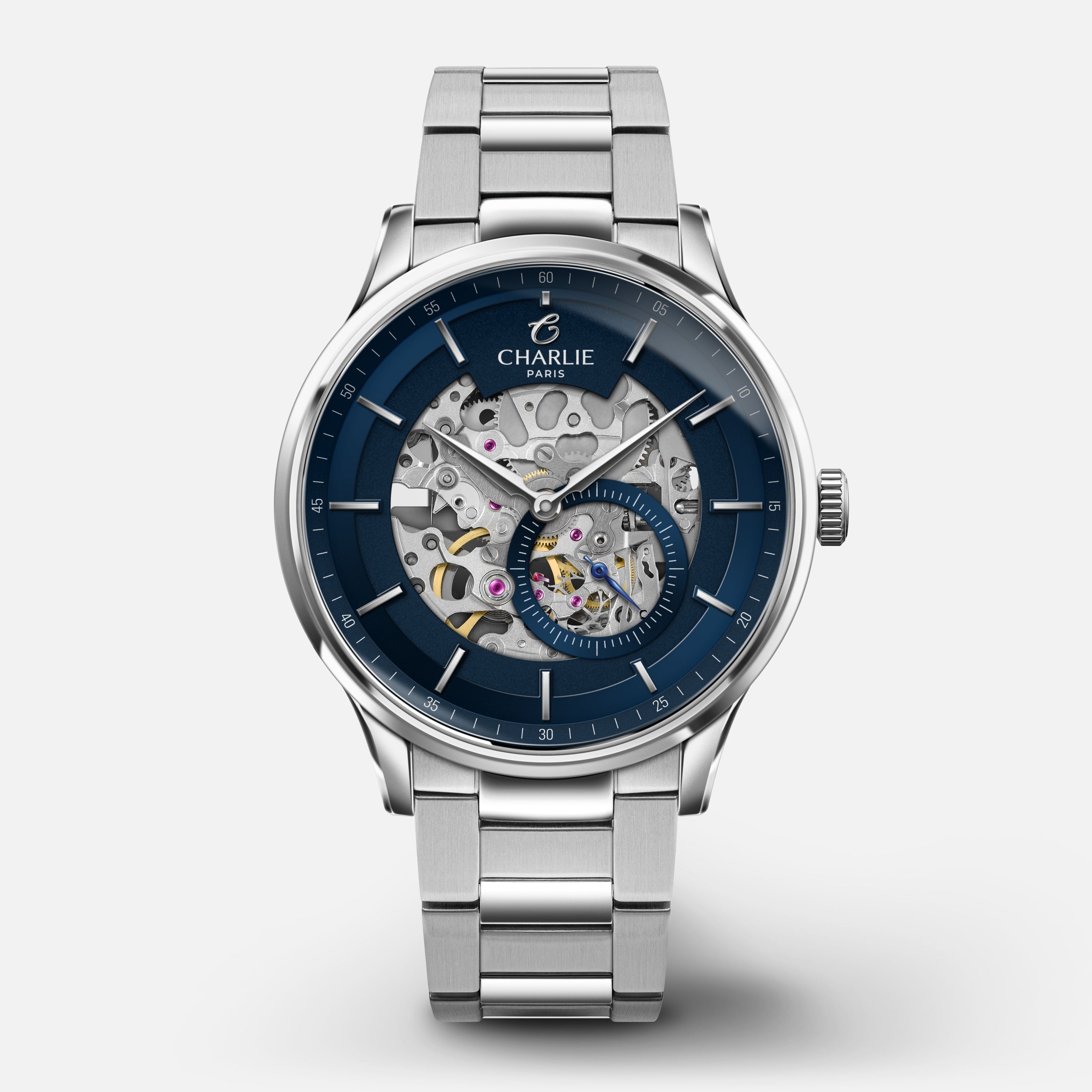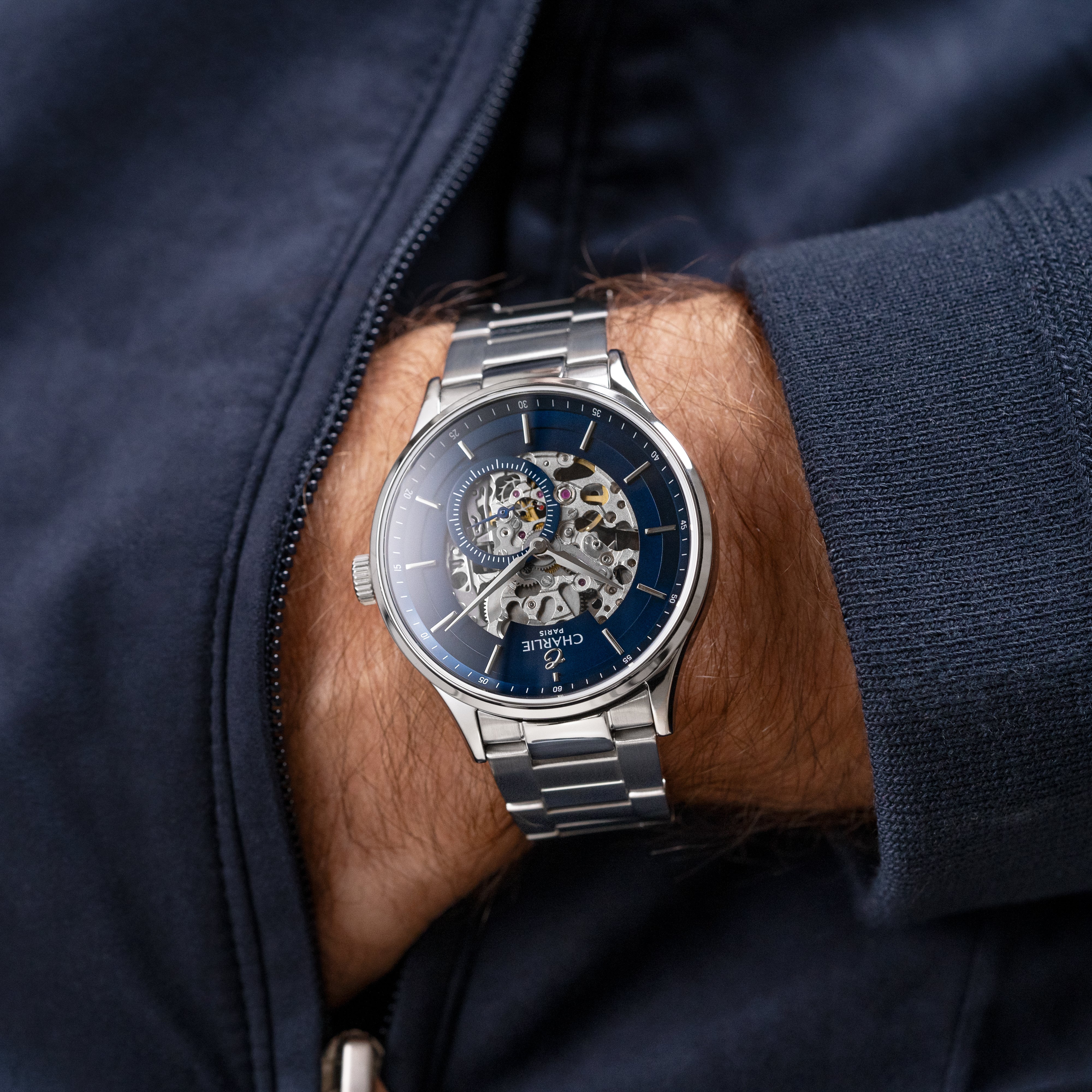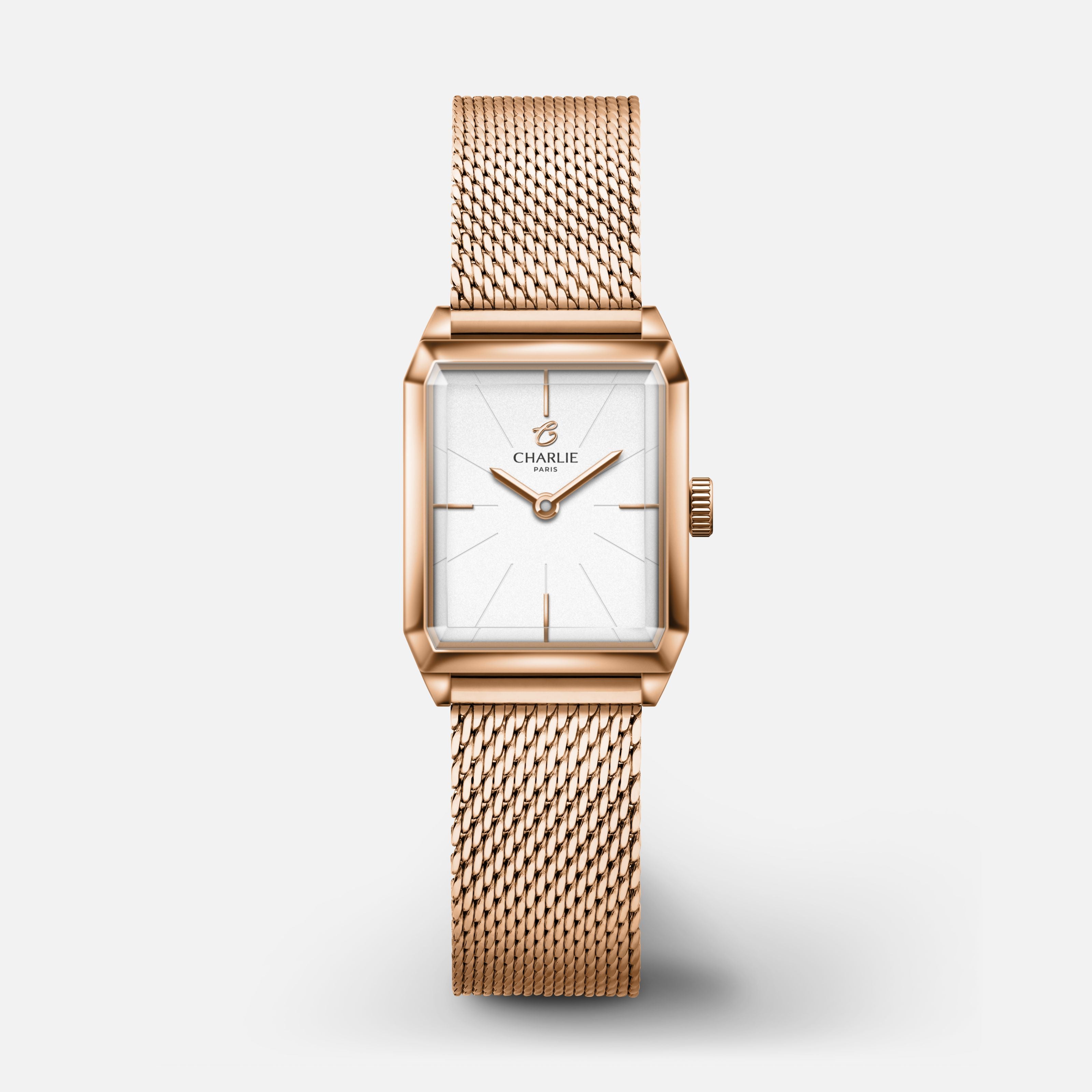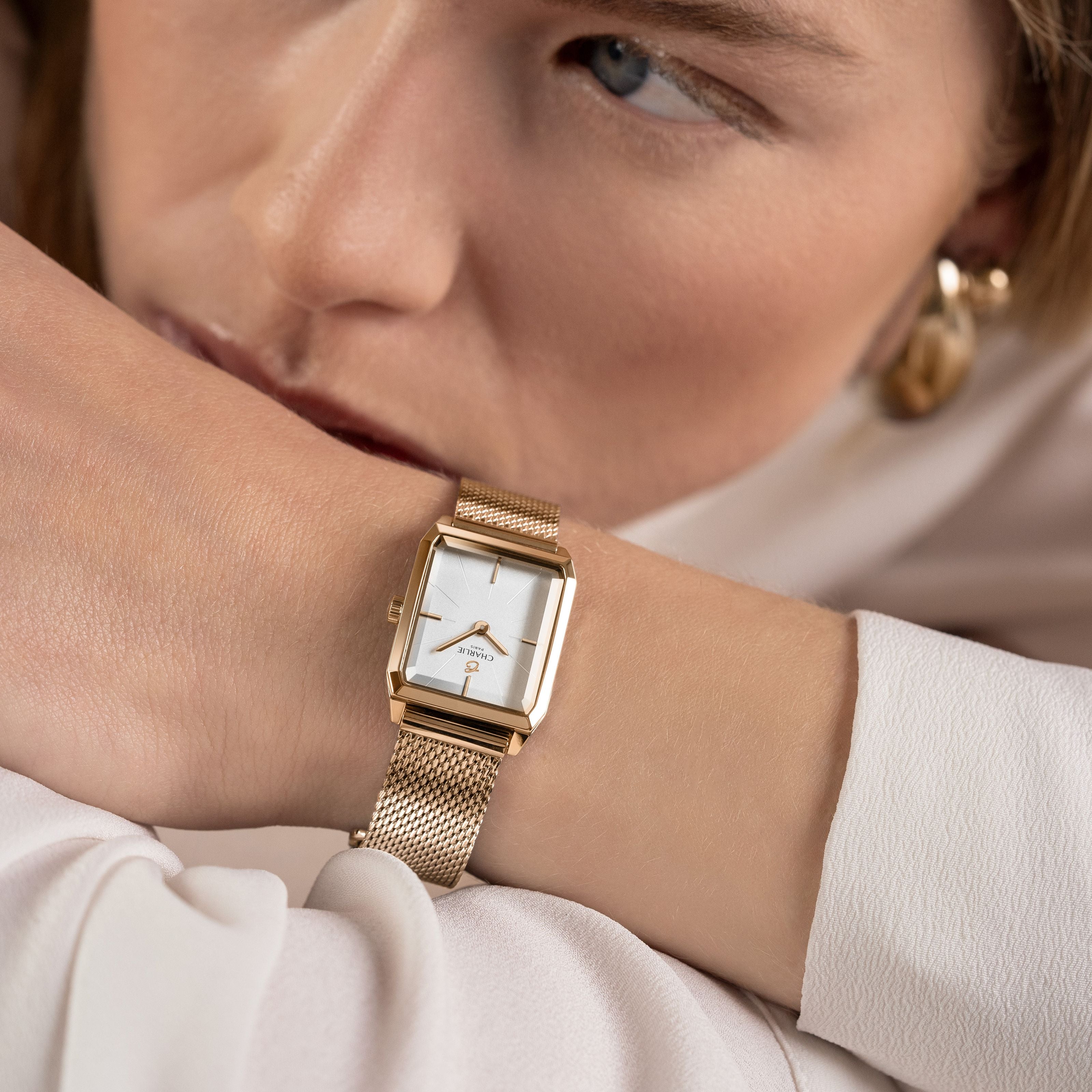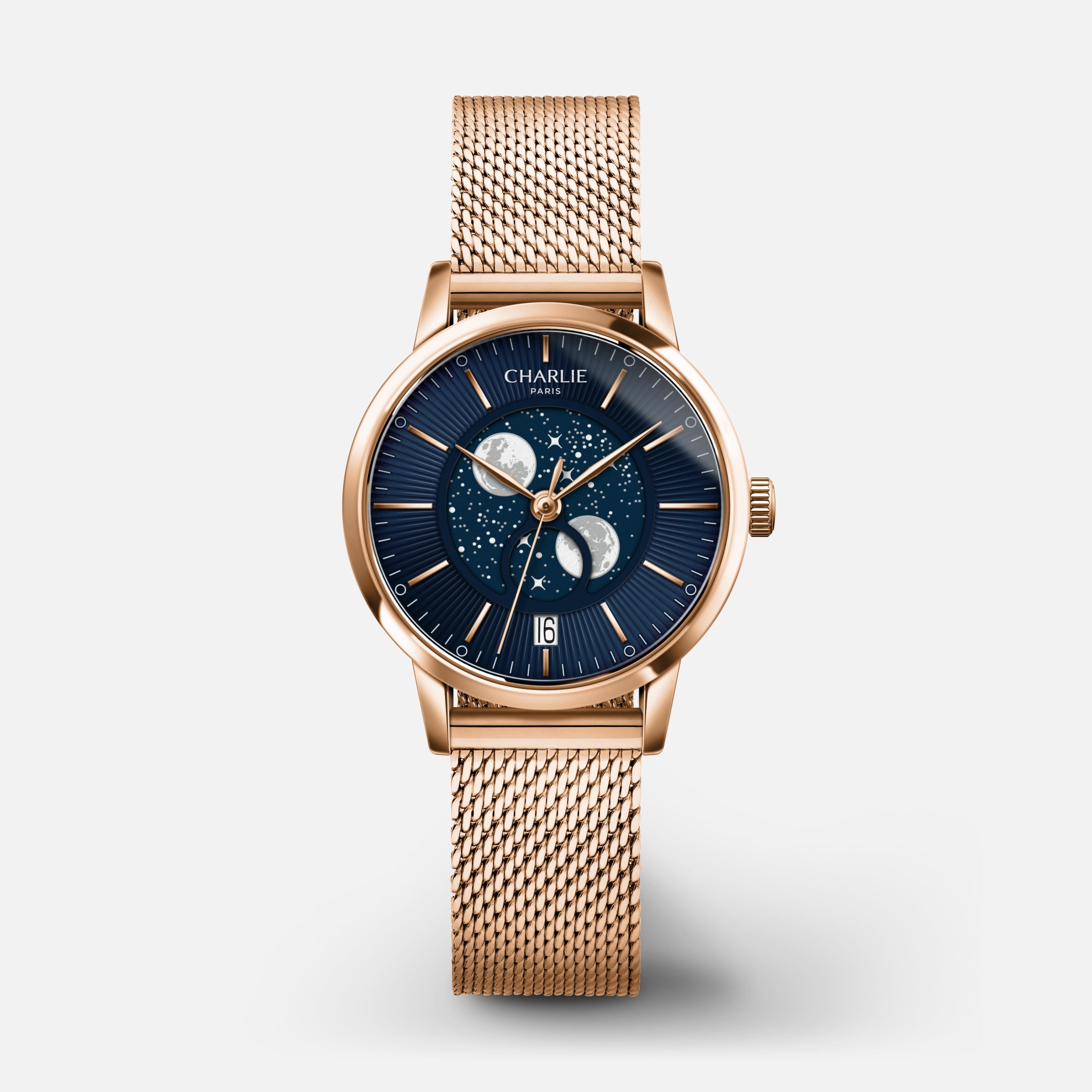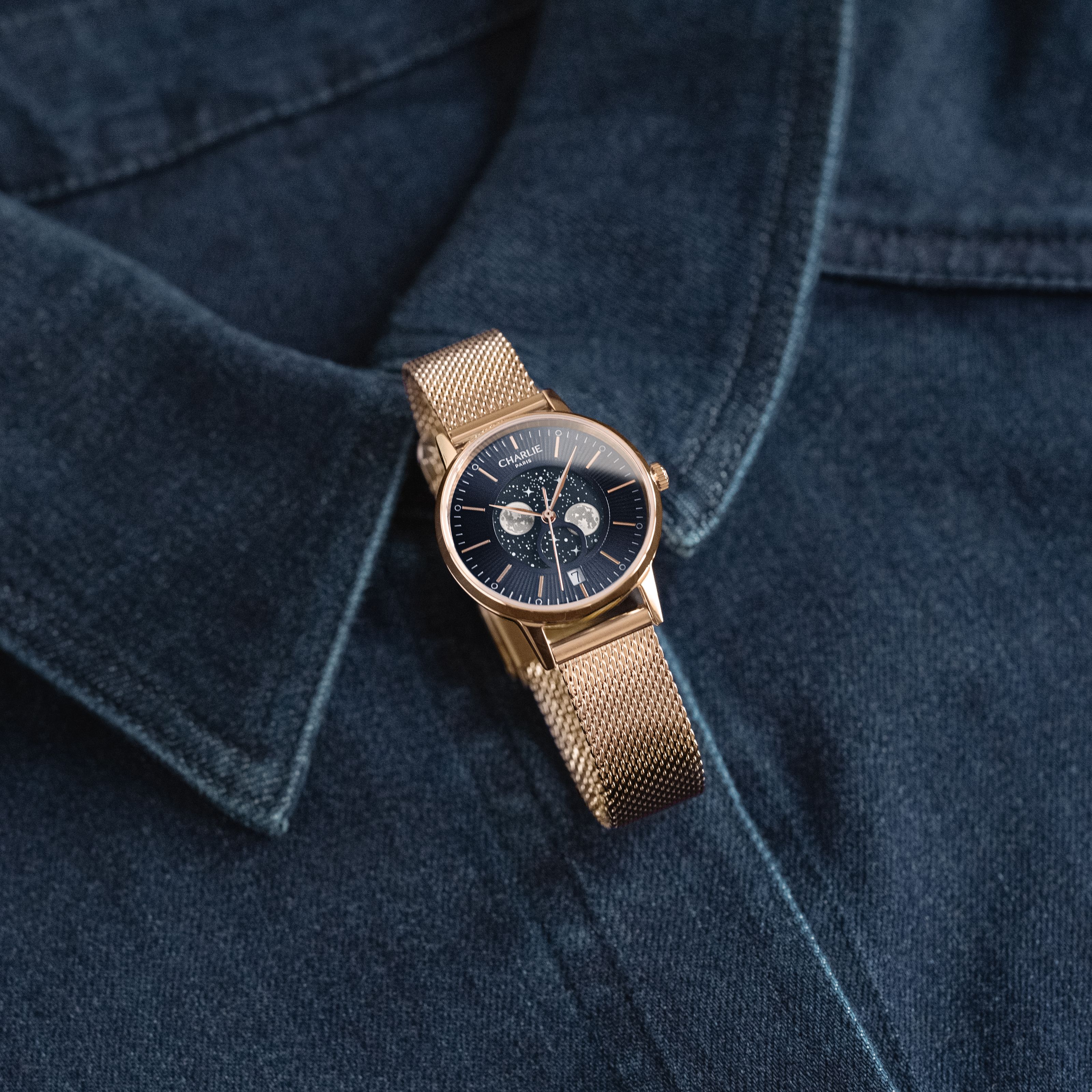Lexicon Watchmaker - Glossary of Watchmaking
Team Charlie Paris knows how much the watchmakers can be complicated to understand but do not worry we thought of you! Here you will find a lexicon gathering the terms watchmakersthat you are likely to meet during your research.For each of these terms we offer a small definition to allow you to better understand them. If you want to know more about a word we invite you to click on the link that will take you to a more complete article. Good reading !
316L steel: 316L steel is a type of austenitic stainless steel whose carbon content does not exceed 0.02%, the amount of chromium is around 17% and the nickel content reaches 10 to 12.5%. At this alloy is added 2 to 2.5% molybdenum. The l of the abbreviation 316L means that it is a "low carbon" steel (low carbon). Indeed, this steel contains only 0.02% carbon against 0.05% for 316 "classic" steel. The 316L steel is very frequently used for the manufacture of boxes and watches. It is an alloy recognized for its durability and also its great resistance to corrosion. From an aesthetic point of view 316L steel is a stainless steel whose brightness continues in time and does not tarnish. Finally, 316L steel relates very easily and in full.
Needle: The needle is a piece of metal, fine and long, which moving on the watch dial, aimed at transmitting time information. Generally, the watches have three needles that indicate hours, minutes and seconds.
Alternation : In clockwise alternation corresponds to the movement of the pendulum of its point of equilibrium towards one of its extremities. The "Tic Tac" of the watch is the translation of this phenomenon. The alternation refers to the movement of a pendulum or an oscillating member. Alternation is used to define the capacity of a caliber of a watch to divide the time interval. The higher this one, the more the watch is able to be precise. We are talking about alternation by hour (A / H). The pendulum of a mechanical watch usually makes 5 alternations at the second, or 18'000 on time.
Applied: The appliques are the indexes or markings cut in a metal plate and then affixed to the dial.
Assembly : Method of assembling all parts of a watch to obtain a complete and finished watch.
ATM : The corresponding atmosphere is the degree of sealing a watch. To give a sealing value, the manufacturer takes as criterion the reference atmospheric pressure which is 1,013 hectopascals, or 1 bar. For example, a 10 ATM watch, means that it resists a pressure of 10 bar, a depth of 100 meters.
Automatique: Movement type equipped with a rotor performing revolutions due to movements of the wrist in order to arm the power spring of a watch.
Swing: Mobile element generally circular, it is the organ which regulates the watch. It was he who made the vibrations in a watch. The pendulum oscillates on its axis of rotation and is coupled to the spring, spring allowing it to print a back and forth, perfectly regular, called oscillation.
Housing : The housing, which aims to protect the watch mechanism dust, moisture and shock. This is the casing of the watch. The housing may be rectangular, square, round, triangular or oval, its profile may be arched or flat.
Buckle: The buckle is the type of clasp most conventional, consisting of a hinged metal tip on a loop for closing a through hole in the strap.
Folding clasp: A clasp is a type of closure of the bracelet of a watch. She is articulate and unfolds when opened. The clasp opens and closes with a push. Depending on the model, it may have different forms, more or less long and wide.
Push buttons : These buttons on the casing of a watch to ensure the application function of certain complications, such as the outbreak, stop and reset the chronograph.
Bracelet : Designed in leather, steel, nylon, flannel, rubber, plastic, etc. The bracelet is the link that allows to wear the watch around the wrist. There are bracelets interchangeable watches as our bracelets Charlie Paris.
Dial: The dial is usually a metal part that provides various information, such as hours, minutes and seconds. There are a variety of dials.
Cadrature : Said pieces that are placed under the dial works Watchmaking.
Caliber: The size corresponds to the type of movement of a watch. This term was used for the first time by Sully in early XVIIIs century to designate the layout and dimensions of the various parts of the movement, wheels, pillars barrel. For al follows, it will indicate the shape of the movement, its origin or the name of the manufacturer.
Groove: Hollow as particularly found on the winding crowns to get a firmer grip on the glasses or to make a stylistic effect. A ride with recess is called fluted watch.
Railway: Railway is called a print timer scale on the dial of a watch. As the name suggests this timer scale resembles the rails of a railroad.
Chronograph: A chronograph is a watch that indicates hours, minutes and seconds. The chronograph is also equipped with a needle that starts, stops and resets the touch of a button. The presence of minute counter and hours allows the total number of laps completed by the chronograph.
Stopwatch: The timer function is placed on a watch high precision. Indeed, for a watch can be called stopwatch, the watch must be extremely accurate and high precision must be certified by tests carried out by an independent body. In Switzerland, the stopwatch function is certified by an appointed body COSC (Official Swiss Chronometer). For a watch timer is approved by the COSC, it must undergo tests in 7 different ambient temperatures ranging from 8 to 38 degrees. The COSC performs these tests to measure and control the accuracy of the watch movement.
Cylinder : The cilindre is a round body and equal size. The rope of a big clock wraps on a wooden cylinder called roller.
Pawl : Piece that holds the rock and the spring bandaged in a pendulum or watch barrel.
Complication: Complications are mechanisms that can possess a watch and add to its basic movement to provide other information than the time and minutes. We then speak of a complicated mount or a complication watch. This can for example have an awakening, a perpetual calendar, a whirlwind, time zones or a chronograph.
Rooster : It is a support for various uses. The rooster of a watch supports and covers the pendulum.
Horn : The horns are located at the top and bottom of the watch box and serve to attach the bracelet to the middle bracelet. The horns are hoiced and allow to connect the barcate the bar, which welcomes the bracelet. The bar, also known as a horn, is a small metal rod that slips into a bracelet hole. Depending on the model to mount and brand, the horns are more or less long, their shape and material vary.
Cosc : The Swiss official control of the chronometers (COSC)is a non-profit association that deals with a certified stopwatch title. For this, a 15-day measurement and control system is rigorously set up to engage the reliability and quality of watches individually.For a mechanical watch, the walking distance tolerated according to the temperatures and positions tested is between -4 and +6 seconds a day.
Crown: The winder crown is a button on the outside of the housing that the user takes between his fingers to go up the watch. It has various forms: knurled or fluted. A pusher crown is a winding wreath that has a moving pusher to start a chronograph mechanism.
Crown targeted: As the name suggests it is a crown that is screwed to improve the tightness of the watch.
Limited editions : A limited edition corresponds to a particularly numbered, frequently numbered watch, and available in limited quantities.
Gear : This is the effect of the tooth of a ride which between Dan the wing of a pinion.
Cottage: Watchmaking, etching is a step in assembling a watch. This step consists in introducing and then fixing the movement of the watch in the housing. After developing and mounted the caliber of the watch, the craftsman sets up the latter in the watch box. The movement is then attached to the dial and the case of the case. The needles are also placed at that time. The watchmaker puts the remonstor of the watch, then checks that no dirt has entered the housing. The ending is a very accurate and delicate operation that requires know-how and technical.
ETA : One of the leading manufacturers of walloss movements based in Switzerland.
Horn: We call the distance between the distance between the two horns of a watch. The inter-corner determines the size of the bracelet of the watch.
Foliot : Former name of the pendulum.
Watch: The bottom of a watch is a part of the watch case, which consists of three distinct parts: the bottom, the middle and the bezel. The bottom of a watch is the lid on the back of the housing. It can arrange all kinds of decorations or information about the watch.The bottom can also be transparent and then allows to see the movement of the watch.The bottom can be clipped on the middle, or screwed to improve sealing.
Frequency: Measured in Hertz, the frequency of a watch refers to the number of oscillations that the pendulum of a watch in a single second (generally between 5 and 10). There are two types of measurements to evaluate the frequency of automatic movement: the hertz and the number of alternations per hour (A / H). The higher the frequency of a watch, the higher the oscillations of the pendulum. These are the oscillations performed by the pendulum that produce the ticking of the watches.
GMT : Abbreviation meaning "Greenwich Mean Time". This term refers to the solar time at the meridian of the Greenwich Observatory in England, a civilian time of 24 hours starting at midnight. On a watch, the GMT function refers to the display of a second time zone simultaneously with the local time.
Counter: The counter is an opening in the dial that allows you to display information. Most often, this is the date and the day.
Guilling: Guillochage is a decorative clockwork technique. This decoration can be applied to the dial and the watch case. The guillocher action "consists of engraving by hand or the guillochy machine on metal".
Hertz: Horlogerie, the hertz (Hz) is used to measure the running frequency of a movement. It is a frequency measurement unit of an event on a second.
Index : The term index refers to a certain marking of hours on the dial of a watch. Traditionally, the watches owned a dial that displayed hours through Roman numerals or Arabic numbers ranging from 1 to 12. Over time, a new way to graduate time on the dial has appeared. Indexes are benchmarks, usually small thin features, which replace the numbers.
Luminescence: Luminescence refers to the emission of light rays. In watchmaking, this is the material covering the index and the needles to read the time in the dark. For this, the LumInova system is used.
Luminova : This is a luminous paste composed of tritum bulbs that allows to store the light and then reflect it once dive in the dark. This material has removed the radium salts present in tritium and thus oust the radioactive property of this material.
Telescope : The telescope is one of the main elements of the housing. It is on the upper part, above the middle, and carries the ice of the watch. This can be rotating to indicate various information such as the duration of an event.
Rotating bezel : Rotary, graduated and disposed bezel on the top of the housing. It serves to record complementary data such as the duration of a phenomenon and equips the dive watches. It can be bi-directional (which turns in both directions) orUnidirectional (which rotates only in one direction), especially as is the case for diving watches.
Magnetization: Magnetization refers to the harmful influence of magnetic fields on the operation of a watch. The magnetic fields are due to smartphones, digital tablets, inducing plates, speakers, televisions, etc. And the watches are sensitive to their waves. A magnetized watch delays or advanced suddenly and can stop without the slightest shock or accident.
Manual : Is said of a mechanical watch that goes back, either with manual winding.
Manufacture: Manufacture is a quality symbol in watchmaking. A manufacture designates a factory producing its products in a traditional way, either in almost all. This term makes echo with a movement entirely developed by a brand.
Oscillating mass : The oscillating mass, also called rotor allows an automatic watch to continue to operate as long as its owner the door on the wrist. The oscillating mass is the room that allows to recharge the barrel spring thanks to the wrist movements. When the watch bottom is transparent, this part is visible at the back of the watch. It is often decorated with engravings, and on generic movements, it usually takes the logo of the brand of the watch.
Analog watch : Watch whose dial, needles, numbers or indexes have the total display of a 12-hour period. The 12-hour analog display shows the time and, if it is integrated, the day and the date.
Mechanical watch: A mechanical watch, in opposition to a quartz watch, is a watch that works without a battery. It is animated by a manual winding movement, requiring to be reassembled every day by turning the crown, or automatic that goes back through the movement of the person via a rotor turning around an axis.
Movement: Watchmaking movement is all parts to operate a watch. There are different types of watch movement: quartz movement, manual winding mechanical motion, mechanical motion with automatic winding. On average, a simple mechanical movement has 130 pieces. Overall, the movement includes the blank, the regulating organs as well as many other elements: springs, pivots, screws, shockproof system, gears, stones, etc.
Regulating organ: The settings, also called regulators, are watch or clock pieces, which will be used to divide the time in seconds, minutes and in hours, sometimes even in hundredths or thousandths of a second. The regulators also serve for the indication of the date or any other type of indication that can be found on watch complications. In a mechanical movement watch, the regulatory organs are the pendulum and the spiral in relation to the anchor watch exhaust. These different parts will receive the energy of the wheels, then they will count and the division of time.
Oscillation: The oscillation represents the return trip of a pendulum or a pendulum between two extreme positions. An oscillation consists of two alternations, it is the famous ticking of a watch.
Small second: The small second allows to display the seconds in a deported counter, unlike the large seconds whose axis is located in the center of the watch. We generally find the small second at 6 or 9 hours.
Platinum : It is one of the plates of the cage of a watch or a pendulum. This plate supports several components of the watch.
Bridge : Tells all the pieces that are fixed and used to wear parts that are located on the plate.
Pusher : This is the pendant or the button of a repeated watch.
Calendar : Watchmaking, the amount of time refers to the day number of the current month. This date indication is either in the form of a rotary disk or a needle.
Annual amount : The annual calendar is a watch complication that allows for the fact that the 12 months of the year do not all have the same number of days. An annual amount is able to correctly display the date of the 1st of the months of 30 days: the date will pass for example directly from April 30 to May 1st without displaying April 31. On the other hand, the transition from February 28 to March 1 requires manual intervention during non-bissextile years
Perpetual quantities: The perpetual calendar is a horological complication that takes into account that the 12 months of the year does not have the same number of days as may do a yearly calendar. But the perpetual calendar takes more account leap years.
Calendarsecular : The perpetual calendar takes into account leap years but it will not be the case on March 1, 2100, centennial year, and therefore not a leap year. This is indeed the peculiarity of the secular calendar: it overlooks the fact that a secular is not a leap year.
Quartz: The quartz movement is an electronic movement including a time base is provided by a quartz crystal oscillated. An electric battery provides the mechanism showing the energy required for its operation. The quartz watches contain a small strip of crystal quartz, a mineral composed of silicon atoms whose characteristic is the piezoelectricity. Quartz has the property of emitting vibrations at regular intervals when subjected to an electrical supply. Unlike a mechanical movement, quartz movement virtually no drift.
Automatic winding: The automatic winding is technically led the manual winding. These are the movements of the wrist that initiate the action of the rotor which then turns on its axis. This movement will row the spring, via a set of gears. The first time you wear an automatic watch, it is necessary to make a manual winding to start the automatic winding mechanism for the future.
Manual winding : Manual winding is to manually rotate the winding crown of a watch. It is also possible to bump an automatic movement manually. Once you feel a slight resistance, the watch is fully wound and you have to stop.
Power reserve: The power reserve is the time of operation of a mechanical watch without the user having to remount. The watch indeed work through the spring tension. When the latter is not tight enough, you must wind the watch, that is to say, give the necessary tension to the spring so that it can restart.
Mainspring: The mainspring is a member regulating the watch. It is a movable part, which generally has a circular shape and performs an oscillatory movement about its axis of rotation. The balance includes a spring named spiral that allows it to describe a movement back and forth perfectly regular. It is this movement that divides time into equal intervals.
Spiral spring : It is a very small tour spirallement blade that is applied to the balance of a watch to adjust vibration.
Ronda : The second largest Swiss manufacturer of movements (after ETA).
Rotor : The rotor also called "rotor" permitsto an automatic watch to continue to run as long as the owner carries the wrist. The oscillating mass is the room that allows to recharge the barrel spring thanks to the wrist movements. When the watch bottom is transparent, this part is visible at the back of the watch. It is often decorated with engravings, and on generic movements, it usually takes the logo of the brand of the watch.
Wheel Exhaust :The escape wheelis a key component of an automatic watch. Its function is to blurt energy channeled through the gears to the anchor, intermittently and regularly. This is the watch body maintenance.
Ruby: Ruby is a precious stone belonging to the Corundum mineral family and is red. Very used in the jewelry sector, it gave its name to a room used in that of watchmaking. Rubies have the function of reducing friction that the watch mechanism causes certain parts of the movement. Rubies limit wear due to these floraments and thus prolong the life of the watch.
Sellita : Sellita, is an independent Swiss company specializing in the assembly of automatic mechanical movements "Swiss Made".
Second: The second is the basic unit of time. Until 1967, it was defined as the fraction of an average solar day. Clocks becoming increasingly accurate, the definition of the second was changed at the October 1967 Weights and Measures Conference to become the second atomic.
Spiral : The spiral is a small spiral spring spring to regulate the movement of a watch. It brings the pendulum back to the initial position to engage a new oscillation. Its quality has a great impact on the accuracy of the given time.
Skeleton: Also called skeleton movement or skeleton watch, the skeleton is an aesthetic technique in which some parts of a watch have been half-up to unveil the workings and all the watchmaking mechanics.
Tachometer : The tachometer is a tool that allows you to measure the speed of movement of an object or person in motion. On a watch, the tachometer is a graduated scale generally placed on the outskirts of the dial and that makes it possible to estimate a medium speed by measuring the time necessary to browse a certain distance. The tachometer usually measures the speed in kilometer per hour and operates most often with the second hand. In the world of watchmaking we find this concept on the chronograph watches.
Rod: The winding stem is a small rod coming out of the watch and can be turned. At the end of the rod of the winder is a wheel, called the wrapping wreath. It serves to connect the outside of the movement for its reassembly and to put it on time or date.
Whirlpool: The tourbillon is a watch complication whose primary purpose is to reduce the effect of severity on the operation of a mechanical watch. By reducing the effect of gravity on the movement of a mechanical watch, the latter becomes more precise. This mechanical device was developed by Abraham-Louis Breguet in 1801. The tourbillon contains the components allowing the back and forth of the pendulum in a small mobile cage in the center of the watch performing a tour per minute.
Tall: The second hand is the name given to the seconds needle that advancing and follows the oscillations of the pendulum. The big second hand is fixed in the center of the dial while the small second hand is placed on a specific dial.
Utc : The acronym UTC stands for "coordinated universal time". As its full name suggests, it is a time scale, it was adopted in 1972 to uniformly define international civil time.
Sapphire glass : Sapphire glass is a material traditionally used in watchmaking and it is very appreciated watchmaking because it is almost inrayable. Sapphire glass is a glass of very good quality, very resistant.
Mineral glass : Type of glass of a watch. It is an affordable glass, relatively resistant to impact and insensitive to U.V rays. The mineral glass is however less resistant than sapphire glass.


